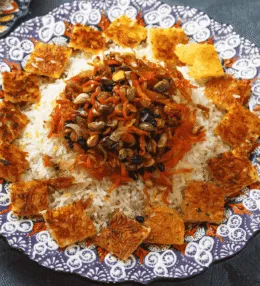
- View
Table of Contents
ToggleHalo-Halo is one of the Philippines’ most colourful and beloved desserts. Its name translates to “mix-mix” in Tagalog, which says everything about how it is eaten and enjoyed. You take a spoon and stir through layers of sweet, cold, chewy, crunchy, creamy textures, creating a joyful mess in a glass.
Often served in tall glasses or wide bowls, Halo-Halo is as much a visual treat as a culinary one. Vibrant ingredients are stacked on crushed ice, crowned with leche flan, purple yam, and a scoop of ice cream. Every spoonful holds a surprise.
It is the kind of dessert that refuses to be quiet. There is colour, crunch, sweetness, and chill in every bite. It plays with contrast and variety, making it one of those dishes you don’t just eat, you experience.
Want to dive deeper into Filipino Cuisine? Don’t miss our post on 28 Traditional Filipino Foods to Try
What Is Halo-Halo?
Halo-Halo is a layered dessert built on a mountain of shaved or crushed ice. Beneath the ice is a mix of preserved fruits, jellies, beans, and sweetened root crops. Milk is poured over the top to bring everything together.
The true charm of Halo-Halo lies in the mixing. No two spoonfuls are the same. One may hold red beans and nata de coco, the next may catch sweet banana and chewy ube. All the elements are meant to blend into a unique balance of taste and texture.
Some versions come in small servings, while others are piled high and meant to be shared. It is enjoyed throughout the year but becomes especially popular during the hot season, offering cool relief wrapped in nostalgia and sugar.
Ingredients and Taste
There is no single recipe for Halo-Halo, but most versions include shaved ice, evaporated milk, and a base of preserved or candied ingredients. Common elements include red mung beans, jackfruit, banana, macapuno, and ube halaya.
Jelly cubes and sago pearls add chew, while sweetened beans bring earthiness. The crushed ice gives it structure and coldness, while evaporated milk softens the sharp chill and ties the flavours together.
The top is where flair comes in. Many versions finish with leche flan, purple yam paste, and sometimes ube or vanilla ice cream. Some even add rice crispies or pinipig for crunch. The result is a cold, creamy, chewy dessert full of contrasts.
A Taste of History
Halo-Halo has roots in both Filipino resourcefulness and foreign influence. It is believed to have evolved from a Japanese dessert called mitsumame, introduced during the early 20th century when Japanese workers settled in the Philippines.
Over time, Filipinos replaced Japanese ingredients with local alternatives. Shaved ice became the foundation, and native ingredients like ube, banana, and coconut jellies took centre stage. It became sweeter, creamier, and unmistakably Filipino.
It was once sold in makeshift stalls and street corners. Today, it appears everywhere from fast food chains to upscale restaurants. Each region has its own version, shaped by the fruits and flavours available in that area.
Halo-Halo is more than just dessert. It is a reminder of how Filipino cuisine brings together tradition, creativity, and the ability to make joy from simple, everyday ingredients. One spoonful and you can taste the layers of history, culture, and pure indulgence.
How to Make Halo-Halo (Shaved Ice Dessert)
Halo-Halo is the Philippines’ quintessential layered shaved ice dessert. A colourful mix of sweetened fruits, jellies, beans, leche flan and shaved ice crowned with purple yam and evaporated milk. Each spoonful is a medley of textures and tropical flavours. See the recipe card at the bottom for printable directions
Ingredients
Base ingredients
- 2 cups finely shaved ice
- 200 ml evaporated milk, chilled
- 4 tbsp sugar (adjust to taste)
Sweetened layers
- 4 tbsp sweetened red mung beans
- 4 tbsp sweetened garbanzo beans
- 4 tbsp sweetened jackfruit strips
- 4 tbsp nata de coco (coconut gel)
- 4 tbsp kaong (sugar palm fruit)
- 4 tbsp sweetened saba bananas, cubed
- 4 tbsp sweetened macapuno strings (coconut sport)
Toppings
- 4 scoops ube halaya (purple yam jam)
- 4 slices leche flan
- 4 scoops ice cream (ube or mango traditional)
- Pinch of pinipig (toasted young rice flakes)
Cooking Instructions
Step 1: Prepare the sweetened ingredients
To begin, ensure all sweetened beans, fruits and jellies are well drained of syrup to avoid watering down the dessert. Use separate bowls for each ingredient for easy layering.
Step 2: Chill the serving glasses
Place tall clear glasses in the fridge for 15 minutes before assembly. This helps keep the layers cool for longer. Move to preparing the shaved ice.
Step 3: Shave the ice
Using a reliable ice shaver, create fine fluffy ice. Keep the shaved ice in a chilled bowl in the freezer until assembly to prevent melting too soon.
Step 4: Begin layering
Add a tablespoon each of sweetened red mung beans, garbanzo beans, and jackfruit strips to the bottom of each glass. Press them gently to create a base.
Step 5: Add the second layer
Continue with nata de coco, kaong, and sweetened saba bananas. Ensure each layer remains distinct for a visually pleasing presentation. Transition to macapuno.
Step 6: Add macapuno and shaved ice
Top each glass with macapuno strings. Then gently pack in shaved ice, pressing lightly with a spoon to create a mound above the rim. Move to pouring milk.
Step 7: Pour evaporated milk
Slowly drizzle chilled evaporated milk over the shaved ice, letting it seep down. This is the step that binds all flavours together.
Step 8: Add ube halaya and leche flan
Place a scoop of ube halaya on top of the ice, followed by a slice of leche flan. These add richness and traditional depth of flavour.
Step 9: Finish with ice cream and pinipig
Top with a scoop of ice cream and a sprinkle of toasted pinipig. This final layer adds crunch and aroma.
Final step: Serve immediately
Serve Halo-Halo with a long spoon. Encourage diners to stir the mixture before eating to enjoy the full spectrum of flavours and textures in every bite.
Variations and substitutions
- Use condensed milk instead of evaporated milk for a sweeter profile.
- Replace ube ice cream with mango ice cream for a tropical twist.
- Add fresh fruits like mango or pineapple for a refreshing note.
Cooking Tips for Perfect Halo-Halo
- Use very finely shaved ice to achieve a smooth, snow like texture.
- Keep all components chilled until just before assembling to prevent quick melting.
- Drain all sweetened fruits and beans thoroughly to avoid excess liquid.
- Assemble just before serving for best texture and presentation.

Filipino Halo-Halo (Mixed Shaved Ice Dessert)
Ingredients
Base ingredients
- 2 cups finely shaved ice
- 200 ml evaporated milk chilled
- 4 tbsp sugar adjust to taste
Sweetened layers
- 4 tbsp sweetened red mung beans
- 4 tbsp sweetened garbanzo beans
- 4 tbsp sweetened jackfruit strips
- 4 tbsp nata de coco coconut gel
- 4 tbsp kaong sugar palm fruit
- 4 tbsp sweetened saba bananas cubed
- 4 tbsp sweetened macapuno strings coconut sport
Toppings
- 4 scoops ube halaya purple yam jam
- 4 slices leche flan
- 4 scoops ice cream ube or mango traditional
- Pinch of pinipig toasted young rice flakes
Instructions
- To begin, ensure all sweetened beans, fruits and jellies are well drained of syrup to avoid watering down the dessert. Use separate bowls for each ingredient for easy layering.
- Place tall clear glasses in the fridge for 15 minutes before assembly. This helps keep the layers cool for longer. Move to preparing the shaved ice.
- Using a reliable ice shaver, create fine fluffy ice. Keep the shaved ice in a chilled bowl in the freezer until assembly to prevent melting too soon.
- Add a tablespoon each of sweetened red mung beans, garbanzo beans, and jackfruit strips to the bottom of each glass. Press them gently to create a base.
- Continue with nata de coco, kaong, and sweetened saba bananas. Ensure each layer remains distinct for a visually pleasing presentation. Transition to macapuno.
- Top each glass with macapuno strings. Then gently pack in shaved ice, pressing lightly with a spoon to create a mound above the rim. Move to pouring milk.
- Slowly drizzle chilled evaporated milk over the shaved ice, letting it seep down. This is the step that binds all flavours together.
- Place a scoop of ube halaya on top of the ice, followed by a slice of leche flan. These add richness and traditional depth of flavour.
- Top with a scoop of ice cream and a sprinkle of toasted pinipig. This final layer adds crunch and aroma.
- Serve Halo-Halo with a long spoon. Encourage diners to stir the mixture before eating to enjoy the full spectrum of flavours and textures in every bite.
Nutrition
You May Also Like







Leave a Review